|
Africa
2024 Journal Pages:
1
2
3
4
5
6
7
8
9
10
11
12
January 16
Jungle oats, toast with peanut
butter and campfire coffee, and we were on the road at 6.30. The
sky was overcast, promising rain. No matter how many impalas I see
I still enjoy them, especially when there are babies - a doe was
standing with two fawns that could have been twins.
Two
black-backed jackals were sitting in the road; one was shaking his
head vigorously, and the other was scratching himself; they must
have had fleas.
A pair of carmine bee-eaters perched
in a tree, and later we saw another of these very attractive birds
on a termite mound. Larger than the other types of bee-eaters we
had seen, they are a rusty red color with sky blue lower bodies,
green on top of their heads, ruby throats and a black mask over
their eyes. We would see more of these unique birds later. A
spotted thick-knee was standing on a log, and a handsome tawny
eagle perched in a treetop.
|
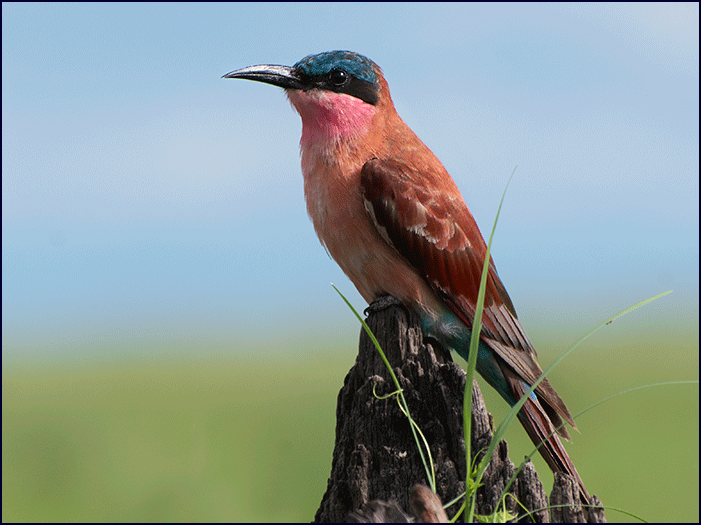
Carmine bee-eater |
Gee spotted a Kori bustard in the grass; these large
handsome birds are the heaviest of all flying birds in Africa.
About the size of a turkey, they are grey, brown, black and white.
They are prevalent in Savuti.
|
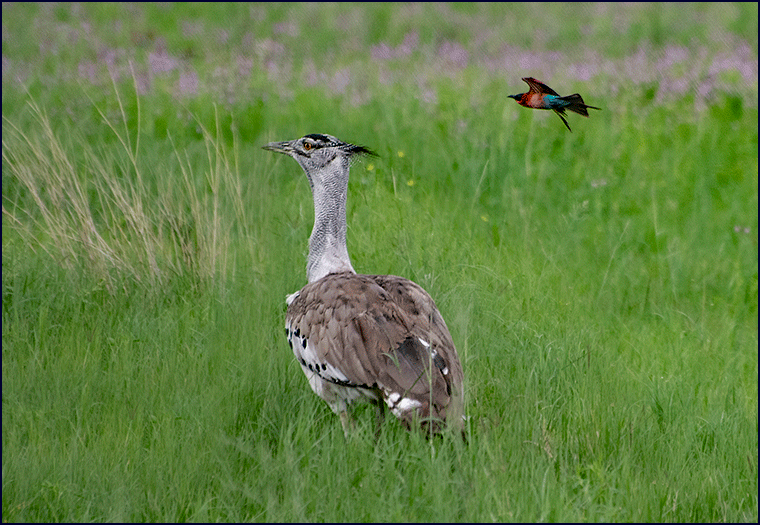
Kori bustard |
We passed a wildebeest daycare
center, and more impala of course. We paused to hang out with a
trio of giraffes. We watched a tiny steenbok as he relieved
himself, and then made quite a production of daintily pawing the
ground to cover his all signs of his business.
|
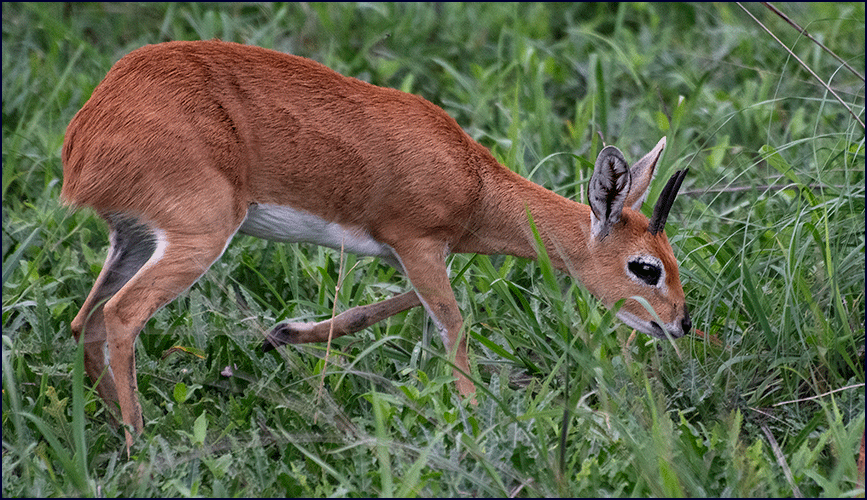
Steenbok
|
A slender mongoose watched us from a
log; he had a long weasel-like body and was a reddish-brown color,
with a black tip on his long tail, and red eyes.
We drove past Kudu Hill and then on
to Bushman’s Rock, a steep hill formed from a large rock
outcropping that juts out of the flat plain. The name refers to
the San people, also known as Bushmen, an ancient hunter/gatherer
tribe that inhabited these plains for centuries. (The term Bushmen
is considered derogatory, so I use the name San instead, except
where it is part of a place-name or title.)
High up on Bushman’s Rock there are ancient rock drawings
made by the San people.
Gee stopped the land cruiser and
checked around for animals, and then we all got out. He led us up
a fairly treacherous path and we scrambled up over the rocks and
past an albaezia tree with white bark that guarded the entrance to
an opening in the rock face. Gee said it was a cave where the San
people lived some 2000 years ago. We climbed up to the shoulder of
the outcropping, and had a fantastic view out over the plains, and
to the other hills in the distance.
|
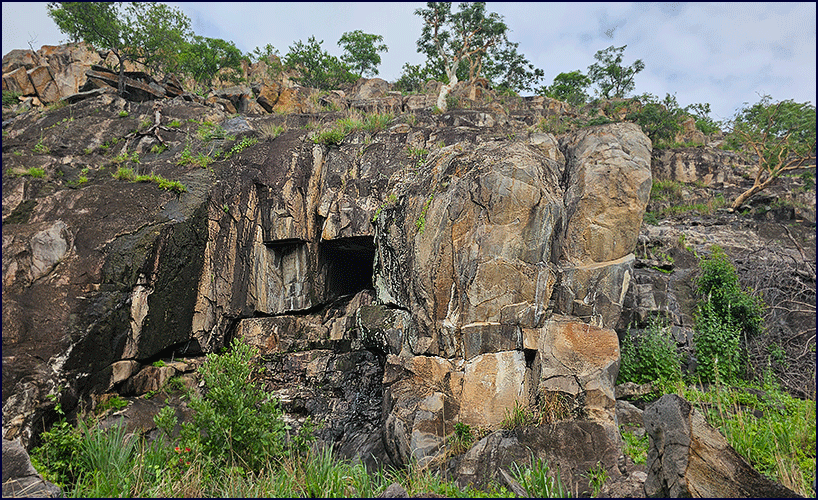
Bushman's Rock
|
There was a large rock face on the
side of the outcropping, and there we could see the Bushman Rock
Drawings. Outlined in a reddish paint, we could clearly see an
elephant with an eland above it, a sable antelope below, and a
faint hippo. There were wavy lines depicting a river, and a bird
below that. I don’t know what the paint was made from, but it
had endured the centuries; these rock drawings are thought to be
between 3000 and 4000 years old.
The sense of history was amazing. The
San people, like many of the indigenous tribes around the world,
had a deep connection with nature and the wildlife, and did not
waste or take more than they needed. If only ‘modern’ man
could treat the earth with such respect the world would be a much
better place.
At the base of one end of Bushman’s
Rock stands an enormous ancient baobab tree, known as the
Bushman’s Baobab. We stopped there for tea. The circumference of
the tree’s mighty trunk must be more than fifty feet around.
This magnificent baobab is said to be two thousand years old.
Imagine the things it has seen, the centuries it has watched pass.
I am in awe of it.
|
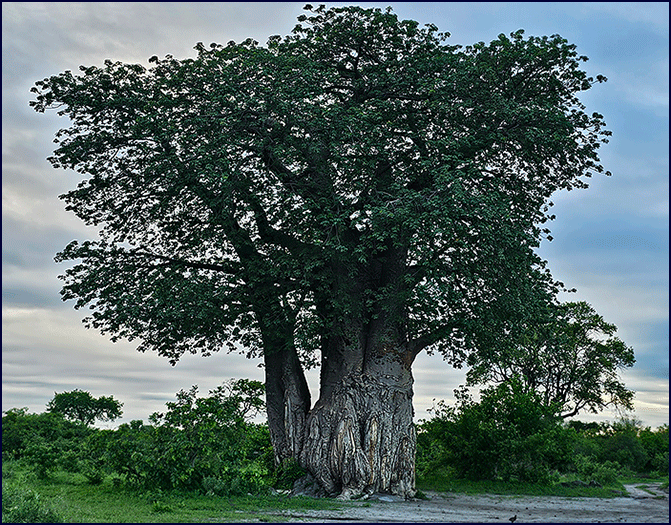
Bushman's Baobab |
I wanted to get a group photo in front of the baobab, so I
asked everyone to line up in front of the tree. I had just taken a
couple of shots when suddenly our group was attacked by bees. Gee
was stung, and Rafe had bees in her hair; we all took off running
and swatting. Now we could see angry bees swarming out of a hole
in the trunk right behind where we had been standing; we realized
there was a hive in the baobab. Plan B - we lined up in front of
the land cruiser for the group photo, but the bees were coming
after us there too – so we hurriedly got back in the vehicle and
drove on.
|
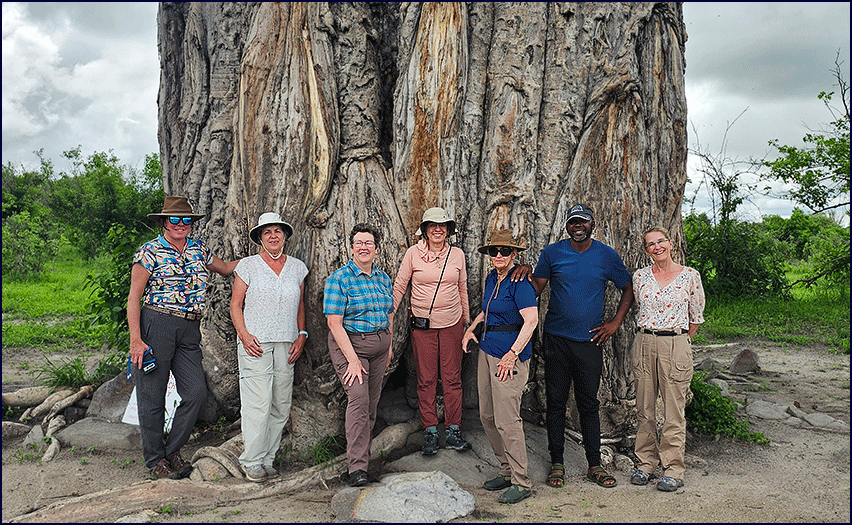
Group photo at Bushman's Baobab, moments before the bee
attach.
|
A martial eagle was standing on a
high perch. He had
long legs, ruffled feathers on his head that formed a topknot, and
a somewhat cruel expression. Gee said they are the largest eagle
in southern Africa, and will eat baby antelopes.
Janell spotted a leopard tortoise
walking through the grass; it moved quicker than you might expect.
It was very pretty, with a mottled black and yellow shell. We got
out for a closer look.
A
rather pretty bird was wading in a large puddle by the road; it
was a painted snipe. It was a rust brown color with white
markings, and had a long bill and a short tail.
Driving across a wet field, we saw
thirteen marabou storks standing in a row; we were surprised to
see so many together. But a bit further on we came upon many more;
there was a flock of 37 of them. These
unappealing birds are sometimes known as the undertaker birds;
they are black with white chests so it looks like they are wearing
a suit, they stand sort of hunched over, and are often seen around
a carcass.
We drove around Leopard Rock, another
huge rocky hill. We had seen a mother leopardess here with young
cubs on a previous trip, but there were no cats around today. We
drove up onto the Sand Ridge and stopped for tea under a
camelthorn acacia tree – no bees this time. Even though the
ridge was not very high, we had a nice view down over the plain
and the hills in the distance. It was raining lightly, and the sky
was stormy.
There was a hornbill in the tree,
feeding his nesting mate through a hole in the trunk. There were
wild cucumber vines growing all around; the vines grow along the
ground, and the plump green fruits have spiny prickles on them.
Gee said he had seen an ostrich eat one of these cucumbers whole,
and watched as the large lump move down its neck.
We headed
back toward the Savuti Channel, passing warthogs and waterbucks. A
pretty red-crested korhaan hid in the grass. We saw a Kori bustard
flying; it was huge. They are always described as Africa's
heaviest flying bird, but I can’t remember having actually seen
one fly before.
The Savuti Channel is actually a
river, or at least it used to be. This
mysterious channel runs for a hundred kilometers, from the Chobe
River to the Mababe Depression, and ends at the Savuti Marsh. Both
the channel and the marsh are dry now. Unlike the Okavango Delta,
which floods seasonally with water coming down the river from the
rains in Angola, the flowing of the Savuti Channel is influenced
by seismic activity under the earth. On researching the
channel’s history, I found that it was running with water back
in Livingstone's time, but then went dry in 1880, and remained so
for about 70 years. A shift in the tectonic plates of the earth
caused it to flow again in 1957, but then it dried up again in the
early eighties. Water flowed again around 2008, and then a few
years later became dry again. Each time the river dries up, it is
devastating for many of the animals that depend on the water,
especially the hippos and fish. When I first visited Savuti in
2015 there was still a little water in the channel, but when I
returned in 2017 it was all gone. Who knows when a seismic shift
will cause the river to flow again?
|
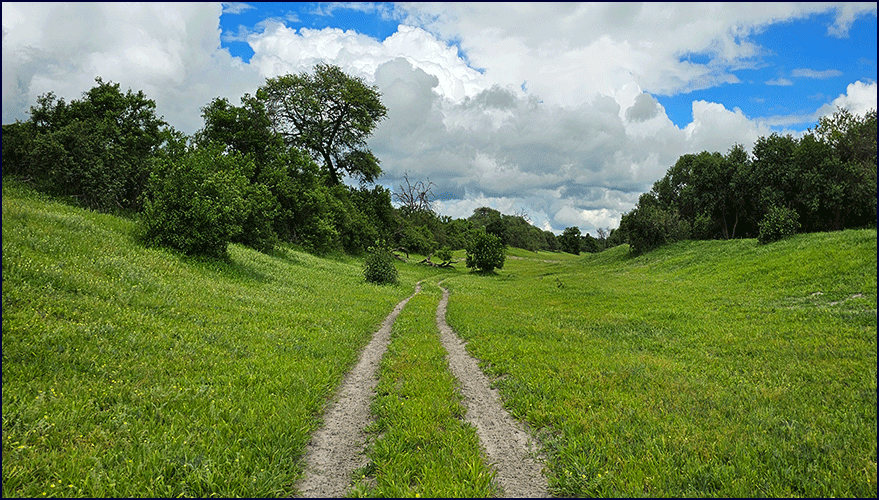
Driving down the Savuti Channel
|
As we neared camp, Gee spotted a dead
impala hanging high in a tree. This was the work of a leopard;
they often carry their kills up into a tree to keep it away from
lions or hyenas. Gee told us that he had a guest ask him once,
“What was that impala doing in that tree before the leopard got
him?”
Gee drove around the area trying to
find the leopard, but we found no other trace. Later Gee talked to
another guide, who told him the leopard who lived in this area was
a very shy female. Some leopards don’t seem to fear vehicles at
all and allow you to get quite close; others are shy and elusive,
and it is almost impossible to find them if they want to hide.
We went back to camp for lunch.
The weather was cooler now than it had been the first part of the
trip, and the temperature was quite comfortable, though still
intermittently rainy. We did some laundry, and we had time for a
little nap.
We went back out around 3.30. We
stopped at the little shop by the park gate to buy a few gifts,
and then we headed out toward Sable Hill.
There was a very large herd of impala near a grove of
trees, and two jackals were checking out one of the small babies.
The adult impalas were not having any of it though; they gathered
round the baby and shielded it from the jackals.
We finally found our male kudus;
there were two of them in the trees. We had seen many female kudus
so far, but this was our first good view of mature males. Though
they were still on the young side, they had impressive long
twisting horns, and a thick two-toned mane hanging from the
underside of their necks as well as along the top. I consider
kudus the most magical of all antelopes – they always seem like
something out of a fairy tale.
We passed another of the large rocky
outcroppings; Gee told us it was Quarry Hill. We constantly had to
ask Gee to identify which of these kopjes was which, because they look different from various angles,
and we were always approaching from a different direction.
We saw several white-backed vultures
sitting in a dead tree. As we got closer we saw more of the
vultures in another tree; there were dozens of them altogether.
Gee searched the area, thinking there might be a lion kill
somewhere near. Before long we found an elephant carcass - this is
what had attracted the vultures.
|
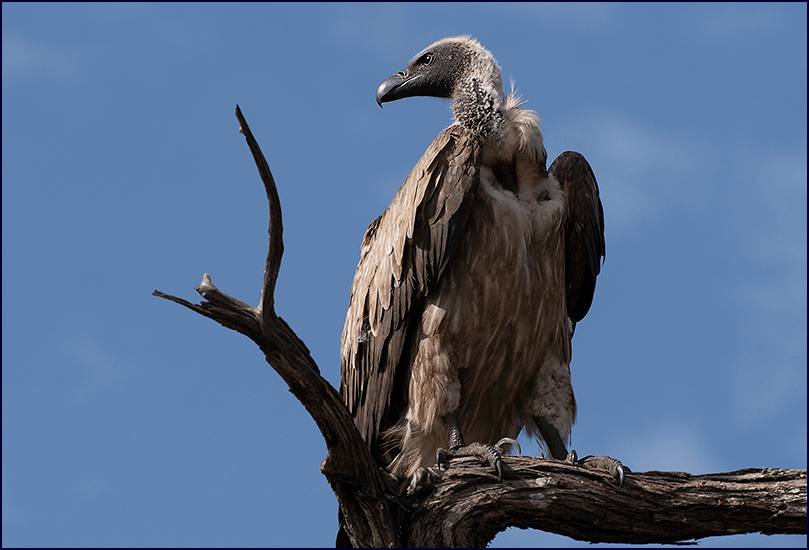
White-backed vulture
|
While certainly not crowded in any
way, we were seeing more game driving vehicles in Savuti. Whenever
we encountered another vehicle Gee would stop and talk briefly
with the guide, exchanging information about wildlife sightings.
The guides would also report to each other by radio. Gee had
learned that two lions had been sighted near Leopard Rock, so we
went to try to find them.
It was quite late by the time we found the two male lions.
They were lazing about on the plain, alternating between lying
flat on their sides, rolling over comically on their backs with
their legs in the air like a dog wanting its belly rubbed, and
occasionally sitting up to look alertly around. We watched them in
the fading light for a while, and then left them to head to camp.
We checked out the tree impala on the way in, but there were no
leopards in sight. ‘What
had that impala been doing in the tree before the leopard got
it?!’
Back in camp we had drinks and dinner, and great
companionship as we reviewed the day and told jokes and stories.
We were happy to have such a great, compatible safari group. It
rained all night.
January
17
It was cloudy and rainy again in
the morning as we set out at 6.30. A pair of very wet tawny eagles
watched us from a high perch as we left camp.
We had seen impala and wildebeest
everywhere we went, but we noticed that the herds of both were
much larger here in Savuti. We came across an impala daycare group
with at least twenty babies. There was a large group of
wildebeests with the smallest babies we had seen yet - they are so
cute when they are little! Gee told us the female wildebeests have
brown on their faces, while the males’ are solid black.
We spent some time watching several elegant giraffes as
they browsed alongside the road. They moved from tree to tree with
slow-motion strides that are deceptively ground-covering; then
they would stop and stare at us with quizzical expressions. They
appear so gentle, but Gee told us they can fight fiercely to
defend themselves or their young from predators – you don’t
want to be kicked by a giraffe.
A male red-crested korhaan walked through the grass. He was
black underneath with a mottled brown back and wings, and large
expressive eyes. I
love photographing the korhaans, because my camera focuses on them
very well. I have noticed on multiple trips that there are some
animals the autofocus has a really hard time locking on to, such
as banded mongoose, Guinea fowl, and sometimes even close-ups of
elephant’s faces - but my lens loves the sharply etched detail
of the korhaan’s feathers. As we watched him, he opened his beak
wide and let out a trilling call.
|
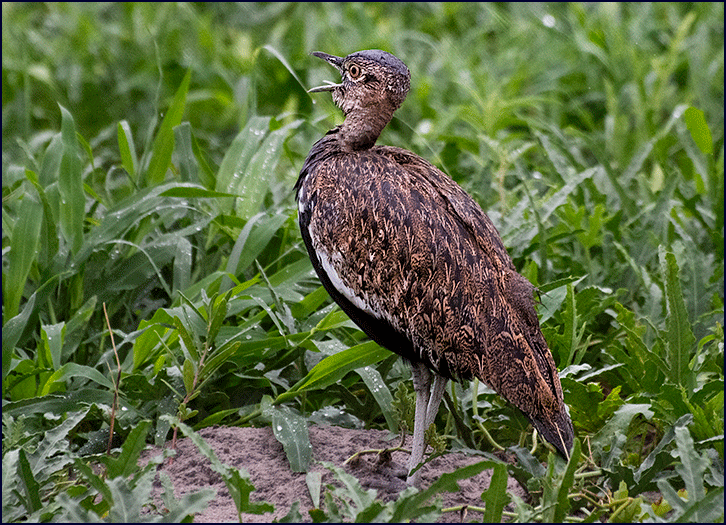
Female red-crested korhaan
|
We went back to the impala tree (who says antelopes don’t grow
on trees?) to look for our leopard. Gee found some tracks and
started following them, listening for alarm calls. There was a
very small road through the bush in the direction the leopard
appeared to have gone, and we went down it.
The road became smaller and smaller, reducing to just a
faint track, and eventually it ended altogether. Several times Gee
heard alarm calls from birds, and we thought we must be very close
to the leopardess. We wandered for quite a long time, circling
round looking for signs or prints. Finally giving up on finding
her, Gee set off to rejoin the road.
We really didn’t mind it when we
were unable to find a certain animal; after all, this was the
wild, not a zoo. There was no guarantee we would see anything
(except maybe impala), and really, the hunt was a large part of
the experience. Sometimes we found the most amazing things when
searching for something else!
Intending
to head back toward the Savuti Channel, we drove and drove through
endless bush. We were in a very remote part of the park now, and
there didn’t seem to be any roads. We were completely alone. We
passed a few familiar-looking trees; perhaps we were going in
circles? Were we lost? Not exactly; Gee wasn’t sure just where
the road was, but he knew roughly where we were. We knew he would
find the way, and in the meantime we were enjoying the adventure.
We were in an area that few people
visit, but there was plenty of wildlife. The usual impala, kudus,
and steenboks were there. Several vultures surveyed the area from
a tree, but we saw no signs of a kill or carcass. We startled a
group of giraffes, and watched as they cantered away in their
slow-motion gait, which is at the same time both elegant and
slightly awkward-looking - I was unsuccessful in my attempts to
get a video of them running.
We were wandering through an area of scrubby trees when
suddenly Gee pointed enthusiastically. ‘Eland!’ he exclaimed.
And indeed, there was one of the large cow-like antelopes,
trotting away from us at the far side of the clearing.
Elands are magnificent creature. The San people depended on
them and revered them, as indicated by the presence of an eland in
the rock paintings. However they have been heavily hunted in the
past (Gee said their meat is very good) so they are shy. He told
us that there are still elands that live in the more remote areas,
he has on occasion seen a herd of hundreds of them together, but
they avoid being where they will be seen. We felt really lucky to
have had two sightings of elands; both had been a distant glimpse,
but that was more than I had hoped for.
It had been several hours now since we had started hunting
for the leopard near the impala tree, and we had seen no signs of
civilization. Finally Gee stopped and climbed up on the roof of
the land cruiser to try and look above the trees; from up there he
could see the Sand Ridge and hills of Savuti, so he immediately
knew which direction to go. I came up with another bad limerick:
We
wandered the veldt high and low
Looking for places predators go
The road was elusive
The leopards reclusive
And where the heck we were we didn’t know.
Now that we knew our direction, Gee quickly found the road
that went past the air strip. Soon we were back out on the open
plains of Savuti, with the Sand Ridge in the background. Three
beautiful giraffes were feeding there; the alpha male was a very
dark color. One of the giraffes cantered gracefully across in
front of us.
~
Continued
on next page ~
Africa
2024 Pages:
1
2
3
4
5
6
7
8
9
10
11
12
Back
to the AFRICA 2024 INDEX Page
|